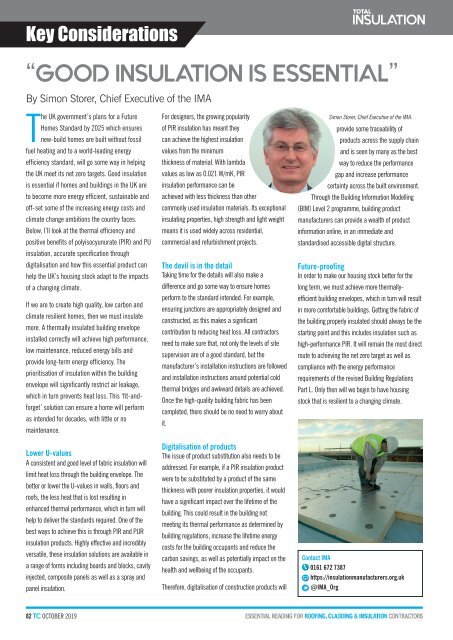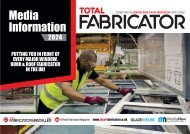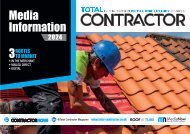October 2019
Create successful ePaper yourself
Turn your PDF publications into a flip-book with our unique Google optimized e-Paper software.
Key Considerations<br />
“GOOD INSULATION IS ESSENTIAL”<br />
By Simon Storer, Chief Executive of the IMA<br />
The UK government’s plans for a Future<br />
Homes Standard by 2025 which ensures<br />
new-build homes are built without fossil<br />
fuel heating and to a world-leading energy<br />
efficiency standard, will go some way in helping<br />
the UK meet its net zero targets. Good insulation<br />
is essential if homes and buildings in the UK are<br />
to become more energy efficient, sustainable and<br />
off-set some of the increasing energy costs and<br />
climate change ambitions the country faces.<br />
Below, I’ll look at the thermal efficiency and<br />
positive benefits of polyisocyunurate (PIR) and PU<br />
insulation, accurate specification through<br />
digitalisation and how this essential product can<br />
help the UK’s housing stock adapt to the impacts<br />
of a changing climate.<br />
If we are to create high quality, low carbon and<br />
climate resilient homes, then we must insulate<br />
more. A thermally insulated building envelope<br />
installed correctly will achieve high performance,<br />
low maintenance, reduced energy bills and<br />
provide long-term energy efficiency. The<br />
prioritisation of insulation within the building<br />
envelope will significantly restrict air leakage,<br />
which in turn prevents heat loss. This ‘fit-andforget’<br />
solution can ensure a home will perform<br />
as intended for decades, with little or no<br />
maintenance.<br />
Lower U-values<br />
A consistent and good level of fabric insulation will<br />
limit heat loss through the building envelope. The<br />
better or lower the U-values in walls, floors and<br />
roofs, the less heat that is lost resulting in<br />
enhanced thermal performance, which in turn will<br />
help to deliver the standards required. One of the<br />
best ways to achieve this is through PIR and PUR<br />
insulation products. Highly effective and incredibly<br />
versatile, these insulation solutions are available in<br />
a range of forms including boards and blocks, cavity<br />
injected, composite panels as well as a spray and<br />
panel insulation.<br />
For designers, the growing popularity<br />
of PIR insulation has meant they<br />
can achieve the highest insulation<br />
values from the minimum<br />
thickness of material. With lambda<br />
values as low as 0.021 W/mK, PIR<br />
insulation performance can be<br />
achieved with less thickness than other<br />
commonly used insulation materials. Its exceptional<br />
insulating properties, high strength and light weight<br />
means it is used widely across residential,<br />
commercial and refurbishment projects.<br />
The devil is in the detail<br />
Taking time for the details will also make a<br />
difference and go some way to ensure homes<br />
perform to the standard intended. For example,<br />
ensuring junctions are appropriately designed and<br />
constructed, as this makes a significant<br />
contribution to reducing heat loss. All contractors<br />
need to make sure that, not only the levels of site<br />
supervision are of a good standard, but the<br />
manufacturer’s installation instructions are followed<br />
and installation instructions around potential cold<br />
thermal bridges and awkward details are achieved.<br />
Once the high-quality building fabric has been<br />
completed, there should be no need to worry about<br />
it.<br />
Digitalisation of products<br />
The issue of product substitution also needs to be<br />
addressed. For example, if a PIR insulation product<br />
were to be substituted by a product of the same<br />
thickness with poorer insulation properties, it would<br />
have a significant impact over the lifetime of the<br />
building. This could result in the building not<br />
meeting its thermal performance as determined by<br />
building regulations, increase the lifetime energy<br />
costs for the building occupants and reduce the<br />
carbon savings, as well as potentially impact on the<br />
health and wellbeing of the occupants.<br />
Therefore, digitalisation of construction products will<br />
Simon Storer, Chief Executive of the IMA.<br />
provide some traceability of<br />
products across the supply chain<br />
and is seen by many as the best<br />
way to reduce the performance<br />
gap and increase performance<br />
certainty across the built environment.<br />
Through the Building Information Modelling<br />
(BIM) Level 2 programme, building product<br />
manufacturers can provide a wealth of product<br />
information online, in an immediate and<br />
standardised accessible digital structure.<br />
Future-proofing<br />
In order to make our housing stock better for the<br />
long term, we must achieve more thermallyefficient<br />
building envelopes, which in turn will result<br />
in more comfortable buildings. Getting the fabric of<br />
the building properly insulated should always be the<br />
starting point and this includes insulation such as<br />
high-performance PIR. It will remain the most direct<br />
route to achieving the net zero target as well as<br />
compliance with the energy performance<br />
requirements of the revised Building Regulations<br />
Part L. Only then will we begin to have housing<br />
stock that is resilient to a changing climate.<br />
Contact IMA<br />
0161 672 7387<br />
https://insulationmanufacturers.org.uk<br />
@IMA_Org<br />
82 TC OCTOBER <strong>2019</strong>

















